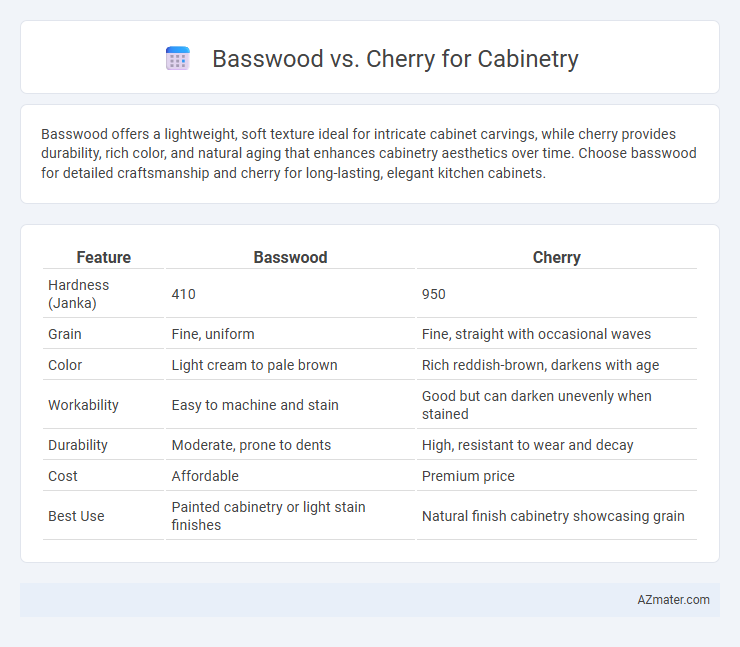Basswood offers a lightweight, soft texture ideal for intricate cabinet carvings, while cherry provides durability, rich color, and natural aging that enhances cabinetry aesthetics over time. Choose basswood for detailed craftsmanship and cherry for long-lasting, elegant kitchen cabinets.
Table of Comparison
| Feature | Basswood | Cherry |
|---|---|---|
| Hardness (Janka) | 410 | 950 |
| Grain | Fine, uniform | Fine, straight with occasional waves |
| Color | Light cream to pale brown | Rich reddish-brown, darkens with age |
| Workability | Easy to machine and stain | Good but can darken unevenly when stained |
| Durability | Moderate, prone to dents | High, resistant to wear and decay |
| Cost | Affordable | Premium price |
| Best Use | Painted cabinetry or light stain finishes | Natural finish cabinetry showcasing grain |
Introduction to Basswood and Cherry for Cabinetry
Basswood and cherry are popular hardwood choices for cabinetry, each offering unique characteristics that influence design and durability. Basswood is prized for its fine, even texture and light color, making it ideal for painted cabinets and detailed carvings. Cherry hardwood boasts a rich, warm reddish-brown hue that deepens with age and exposure to light, providing a timeless and elegant finish favored in traditional and high-end cabinetry.
Appearance and Color Differences
Basswood offers a pale, creamy white color with a subtle grain pattern, ideal for a clean and understated cabinetry look. Cherry wood features a rich, reddish-brown hue that deepens and develops a warm patina over time, adding elegance and character. The distinct color transformation in cherry contrasts with basswood's consistent light tone, making cherry a preferred choice for a classic or traditional aesthetic.
Grain Patterns and Texture Comparison
Basswood features a smooth, fine, and uniform grain pattern with a very light, almost creamy texture that makes it ideal for paints and finishes, offering a clean and consistent look. Cherry wood displays a rich, tight grain with subtle waves and a natural luster, providing warmth and depth through its reddish-brown hues that deepen over time. The contrasting grain and texture qualities make basswood preferred for a sleek, minimalist cabinetry style, while cherry delivers a more traditional, elegant appearance with pronounced character.
Durability and Strength Analysis
Basswood offers moderate durability with a softer texture, making it prone to dents and scratches compared to cherry wood, which is known for its superior hardness and strength. Cherry's tight grain structure and density provide excellent resistance to wear, making it ideal for long-lasting cabinetry. For cabinetry that demands higher durability and strength, cherry is the preferred choice due to its ability to withstand heavy usage over time.
Workability and Ease of Machining
Basswood offers superior workability and ease of machining due to its soft texture and fine, even grain, making it ideal for intricate cabinetry details and smooth finishes. Cherry, while harder and denser, provides a sturdy surface but requires sharper tools and more careful handling to avoid tear-out and ensure clean cuts. Both woods respond well to sanding and staining, but Basswood's forgiving nature makes it more accessible for beginners or detailed woodworking projects.
Cost and Availability Considerations
Basswood offers a more budget-friendly option for cabinetry, with its lower cost compared to cherry wood making it appealing for cost-conscious projects. Cherry wood, prized for its rich color and fine grain, tends to be more expensive and less readily available, influencing overall project budgets and timelines. Availability of basswood is generally more consistent due to faster growth rates and wider regional supply, whereas cherry wood's slower maturation results in higher costs and limited stock in some markets.
Finishing Qualities: Staining and Painting
Basswood offers excellent finishing qualities for cabinetry, featuring a fine, even grain that absorbs stains evenly, resulting in a smooth, uniform appearance. Cherry wood, prized for its natural rich color and smooth texture, takes stains well but is often left natural or lightly finished to showcase its deepening hue over time. For painting, basswood's uniform surface provides a superior base, minimizing blotches and enhancing paint adhesion, while cherry may require more surface preparation to achieve an even finish.
Environmental Impact and Sustainability
Basswood is a highly sustainable choice for cabinetry due to its fast growth rate and widespread availability, resulting in lower environmental impact compared to slower-growing species. Cherry wood, while prized for its rich color and durability, grows more slowly and is often harvested from older, mature trees, contributing to greater ecological strain and reduced sustainability. Selecting basswood for cabinetry supports responsible forestry practices, promoting carbon sequestration and minimizing habitat disruption.
Best Applications for Each Wood
Basswood offers a lightweight, soft texture ideal for intricate carvings, painted finishes, and cabinet doors requiring fine detail work, making it perfect for custom cabinetry and decorative panels. Cherry wood boasts a rich, warm tone with excellent durability, best suited for high-end cabinetry, solid wood furniture, and applications where natural wood grain and aging improve the aesthetics over time. Both woods serve specific roles in cabinetry, with basswood excelling in detailed, painted projects and cherry favored for its strength and timeless, elegant appearance.
Conclusion: Choosing Between Basswood and Cherry
Basswood offers a softer texture and lighter color, making it ideal for painted cabinetry that requires smooth finishes and easy staining. Cherry provides rich warmth, deep natural hues, and excellent durability, perfect for timeless, high-end cabinetry with visible wood grain. Selecting between basswood and cherry depends on whether a sleek, modern look or a classic, elegant aesthetic is preferred for the cabinetry design.

Infographic: Basswood vs Cherry for Cabinetry
 azmater.com
azmater.com